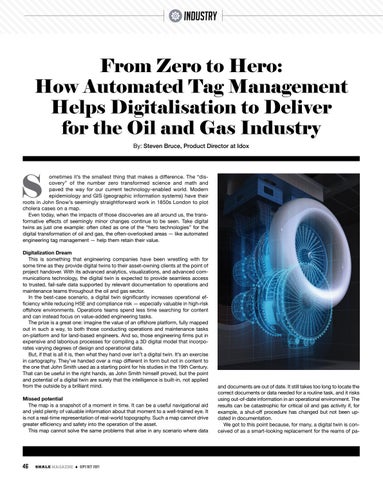INDUSTRY
From Zero to Hero: How Automated Tag Management Helps Digitalisation to Deliver for the Oil and Gas Industry By: Steven Bruce, Product Director at Idox
S
ometimes it’s the smallest thing that makes a difference. The “discovery” of the number zero transformed science and math and paved the way for our current technology-enabled world. Modern epidemiology and GIS (geographic information systems) have their roots in John Snow’s seemingly straightforward work in 1850s London to plot cholera cases on a map. Even today, when the impacts of those discoveries are all around us, the transformative effects of seemingly minor changes continue to be seen. Take digital twins as just one example: often cited as one of the “hero technologies” for the digital transformation of oil and gas, the often-overlooked areas — like automated engineering tag management — help them retain their value. Digitalization Dream This is something that engineering companies have been wrestling with for some time as they provide digital twins to their asset-owning clients at the point of project handover. With its advanced analytics, visualizations, and advanced communications technology, the digital twin is expected to provide seamless access to trusted, fail-safe data supported by relevant documentation to operations and maintenance teams throughout the oil and gas sector. In the best-case scenario, a digital twin significantly increases operational efficiency while reducing HSE and compliance risk — especially valuable in high-risk offshore environments. Operations teams spend less time searching for content and can instead focus on value-added engineering tasks. The prize is a great one: imagine the value of an offshore platform, fully mapped out in such a way, to both those conducting operations and maintenance tasks on-platform and for land-based engineers. And so, those engineering firms put in expensive and laborious processes for compiling a 3D digital model that incorporates varying degrees of design and operational data. But, if that is all it is, then what they hand over isn’t a digital twin. It’s an exercise in cartography. They’ve handed over a map different in form but not in content to the one that John Smith used as a starting point for his studies in the 19th Century. That can be useful in the right hands, as John Smith himself proved, but the point and potential of a digital twin are surely that the intelligence is built-in, not applied from the outside by a brilliant mind. Missed potential The map is a snapshot of a moment in time. It can be a useful navigational aid and yield plenty of valuable information about that moment to a well-trained eye. It is not a real-time representation of real-world topography. Such a map cannot drive greater efficiency and safety into the operation of the asset. This map cannot solve the same problems that arise in any scenario where data
46
SHALE MAGAZINE SEPT/OCT 2021
and documents are out of date. It still takes too long to locate the correct documents or data needed for a routine task, and it risks using out-of-date information in an operational environment. The results can be catastrophic for critical oil and gas activity if, for example, a shut-off procedure has changed but not been updated in documentation. We got to this point because, for many, a digital twin is conceived of as a smart-looking replacement for the reams of pa-














